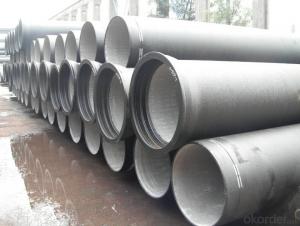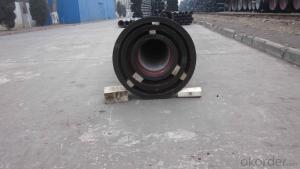DUCTILE IRON PIPE DN900
- Loading Port:
- China Main Port
- Payment Terms:
- TT OR LC
- Min Order Qty:
- -
- Supply Capability:
- -
OKorder Service Pledge
OKorder Financial Service
You Might Also Like
Specification:
1) The standard of pipe: ISO2531:1998, K9
2) Effective length: 6m
3) Inner cement line: Portland cement line as per ISO4179
4) Zinc coating: at least 130g/m2 as per ISO8179
5) Bitumen painting: at least 70um as per ISO8179
6) With 100% quantity of NBR ring, or SBR ring, or EPDM ring as per ISO4633
7) DN80mm-800mm
8) High strength, lighter than grey iron, good corrosion resistance, no furring, small flow resistance, easy fixing, long life tome about 100 yeas
9) Produced by Hangzhou chunfeng machine
10) Checked by automatic inspection equipment
11) Composition:
Chemical composition | |||
Chemical composition | Ductile Cast Iron Pipe (%) | Grey iron pipe (%) | Steel pipe (%) |
C | 3.5-4.0 | 3.2-3.8 | 0.1-0.2 |
Si | 1.9-2.6 | 1.4-2.2 | 0.15-0.4 |
Mn | 0.15-0.45 | 0.4-0.6 | 0.3-0.6 |
P | ≤0.06 | ≤0.3 | 0.02-0.03 |
S | ≤0.02 | ≤0.1 | 0.02-0.03 |
Mg | 0.03-0.06 |
|
|
12) Feature:
Mechanical properties | |||
| Ductile Cast Iron Pipe | Grey Iron Pipe | Steel Pipe |
Tensile Strength(Mpa) | ≥420 | 150-260 | ≥400 |
Yield Strength(Mpa) | ≥300 | No Confirmation | No Confirmation |
Bending Strength(Mpa) | ≥590 | 200-360 | ≥400 |
Elongation (%) | ≥10 | Neglected | ≥18 |
Brinell Hardness(HBS) | ≤230 | ≤230 | About 140 |
13) T type mechanical joint
14) Packing: in bulk or container
- Q:How to control mortar proportioning in ductile iron pipe cement coating
- The calculation steps are: first to calculate the amount of plastering engineering (area), and then check the "national construction basic quota" quota in the corresponding amount of mortar project, engineering quantity multiplied by the amount of mortar that fixed amount of mortar, the mortar amount multiplied by the corresponding mix ratio of mortar, the consumption of raw materials can be obtained.
- Q:Do ductile iron pipes require internal lining for potable water applications?
- Yes, ductile iron pipes do require internal lining for potable water applications. This is because the iron used in these pipes can react with the water and potentially contaminate it. Internal lining acts as a barrier between the water and the iron, preventing any chemical reactions and ensuring the water remains safe for consumption.
- Q:What is the expected leakage rate of ductile iron pipes?
- The leakage rate of ductile iron pipes can vary depending on several factors, including pipe age, condition, installation quality, and external influences on pipe integrity. However, in comparison to other pipe types, ductile iron pipes are renowned for their durability and low leakage rates. Based on industry standards and studies, well-maintained and correctly installed ductile iron pipes typically have an expected leakage rate of less than 0.5 liters per pipe per day (LPPD). This leakage rate meets the requirements set by regulatory bodies and organizations, and is considered acceptable. It is crucial to emphasize that regular maintenance and inspections are vital in sustaining the low leakage rate of ductile iron pipes. Prompt identification and repair of potential leaks or damages can effectively minimize the overall leakage rate. Moreover, advancements in manufacturing techniques and pipe design have led to the creation of more leak-resistant ductile iron pipes. These pipes may have even lower expected leakage rates than the industry average, further improving their performance and reliability. Ultimately, when properly installed and maintained, ductile iron pipes are a reliable choice for various water distribution and transmission systems, as their expected leakage rate is generally low.
- Q:Method for cutting large diameter ductile iron pipe
- When the volume ratio of oxygen and acetylene is less than 1, a carbonized flame is obtained. Because of less oxygen and incomplete combustion, the flame is longer than the neutral flame and the temperature is lower. Acetylene in the carbide flame is suitable for welding high carbon steel, cast iron and cemented carbide materials. When welding other materials with a carbide flame, the weld metal becomes hard and brittle.
- Q:Can ductile iron pipes be used for pressure surge applications?
- Yes, ductile iron pipes can be used for pressure surge applications. Ductile iron is known for its high strength and durability, making it suitable for handling pressure surges caused by water hammer or other transient events. It has the ability to absorb and withstand these sudden pressure changes without experiencing significant damage or failure. However, proper design considerations and installation techniques should be followed to ensure the safe and effective use of ductile iron pipes in pressure surge applications.
- Q:How is ductile iron pipe recycled?
- Ductile iron pipe, a material known for its durability, is commonly used in infrastructure systems like water and wastewater pipelines. Rather than being disposed of in landfills, ductile iron pipe can be recycled when it reaches the end of its life cycle. The recycling process for ductile iron pipe begins by removing it from the ground. Typically, a trench is dug to access the pipe, which is then cut into smaller, manageable sections using specialized equipment. These sections are then transported to a recycling facility. At the recycling facility, the ductile iron pipe undergoes further processing to eliminate any contaminants. This involves removing any fittings or joints that may be attached to the pipe. Additionally, non-iron materials like rubber gaskets or coatings are separated and discarded. Once the pipe has been cleaned and prepared, it is usually crushed or shredded into smaller pieces. This increases the material's surface area, making it easier to melt down in the next stage of the recycling process. The crushed or shredded ductile iron pipe is then melted in a furnace at high temperatures, a process called smelting. Smelting converts the solid iron into a liquid state. During this process, impurities and any remaining non-iron materials rise to the surface and are removed. After smelting, the molten iron is poured into molds to create new products. These molds can produce various ductile iron products, including new pipes, fittings, valves, and manhole covers. The recycled ductile iron products possess the same qualities and durability as those made from virgin materials. Recycling ductile iron pipe not only reduces the need for new materials but also conserves energy and resources. The recycling process requires less energy compared to producing iron from raw materials, resulting in a lower carbon footprint. Furthermore, recycling ductile iron pipe helps minimize waste and promotes a circular economy by giving new life to a previously discarded material.
- Q:How are ductile iron pipes protected against internal scaling or buildup?
- Ductile iron pipes are protected against internal scaling or buildup through the use of various coatings and linings. One commonly used method is cement mortar lining, where a layer of cement mortar is applied to the inner surface of the pipe to prevent scaling and corrosion. Additionally, epoxy coatings are also utilized, which provide a smooth and protective layer that inhibits the formation of scale and buildup. These protective measures help to ensure the longevity and efficiency of ductile iron pipes in various applications.
- Q:Are ductile iron pipes suitable for industrial water systems?
- Yes, ductile iron pipes are suitable for industrial water systems. Ductile iron pipes are known for their strength, durability, and corrosion resistance, making them an ideal choice for transporting water in industrial settings. They can withstand high-pressure and heavy-duty applications, making them suitable for conveying water in large-scale industrial facilities such as power plants, factories, and chemical plants. Additionally, ductile iron pipes have the ability to handle a wide range of temperatures, making them suitable for both hot and cold water systems. Their inherent flexibility allows for easy installation and maintenance, further adding to their suitability for industrial water systems. Overall, ductile iron pipes are a reliable and cost-effective solution for industrial water transportation needs.
- Q:What are the different joint types available for ductile iron pipes?
- Ductile iron pipes offer various joint types that are essential for maintaining the integrity and reliability of the pipeline system. 1. The push-on joint is the most prevalent joint used for ductile iron pipes. It involves inserting a rubber gasket into the bell end of the pipe and then pushing the spigot end into the bell, ensuring a tight seal. This joint is easy to assemble, quick, and has excellent resistance against soil movement and water pressure. 2. The mechanical joint involves a gland and follower that are secured around the spigot end of the pipe using bolts and nuts. It provides a robust and durable connection and is commonly used for larger diameter pipes or applications that expect higher pressure or thrust loads. 3. Flanged joints are utilized when connecting pipes to other components like valves or fittings. The pipe ends are machined and equipped with flanges that are bolted together using gaskets, ensuring a secure connection. These joints find frequent use in industrial applications or situations requiring frequent disassembly. 4. Restrained joints are designed to withstand significant external forces and prevent separation or pulling apart of the pipe. They typically combine mechanical joint components, such as bolts and glands, with additional restraining elements like welded or bolted-on restraints. These joints are commonly employed in high-pressure applications or situations where substantial external forces are present. Choosing the appropriate joint type is crucial and depends on factors such as pipeline design, operating conditions, and installation requirements. Seeking guidance from experienced engineers or pipe manufacturers can aid in determining the most suitable joint type for a specific ductile iron pipe application.
- Q:Can ductile iron pipes be used for both water and sewage systems?
- Yes, ductile iron pipes can be used for both water and sewage systems. Ductile iron pipes are known for their high strength and durability, making them suitable for a wide range of applications, including water supply and sewage systems. These pipes have a high resistance to corrosion, making them ideal for carrying both clean water and sewage. Additionally, ductile iron pipes have excellent mechanical properties, allowing them to withstand the high pressure and stress that can be present in water and sewage systems. Therefore, ductile iron pipes are a reliable and versatile choice for both water and sewage systems.
1. Manufacturer Overview |
|
|---|---|
| Location | |
| Year Established | |
| Annual Output Value | |
| Main Markets | |
| Company Certifications | |
2. Manufacturer Certificates |
|
|---|---|
| a) Certification Name | |
| Range | |
| Reference | |
| Validity Period | |
3. Manufacturer Capability |
|
|---|---|
| a)Trade Capacity | |
| Nearest Port | |
| Export Percentage | |
| No.of Employees in Trade Department | |
| Language Spoken: | |
| b)Factory Information | |
| Factory Size: | |
| No. of Production Lines | |
| Contract Manufacturing | |
| Product Price Range | |
Send your message to us
DUCTILE IRON PIPE DN900
- Loading Port:
- China Main Port
- Payment Terms:
- TT OR LC
- Min Order Qty:
- -
- Supply Capability:
- -
OKorder Service Pledge
OKorder Financial Service
Similar products
New products
Hot products
Hot Searches
Related keywords





























